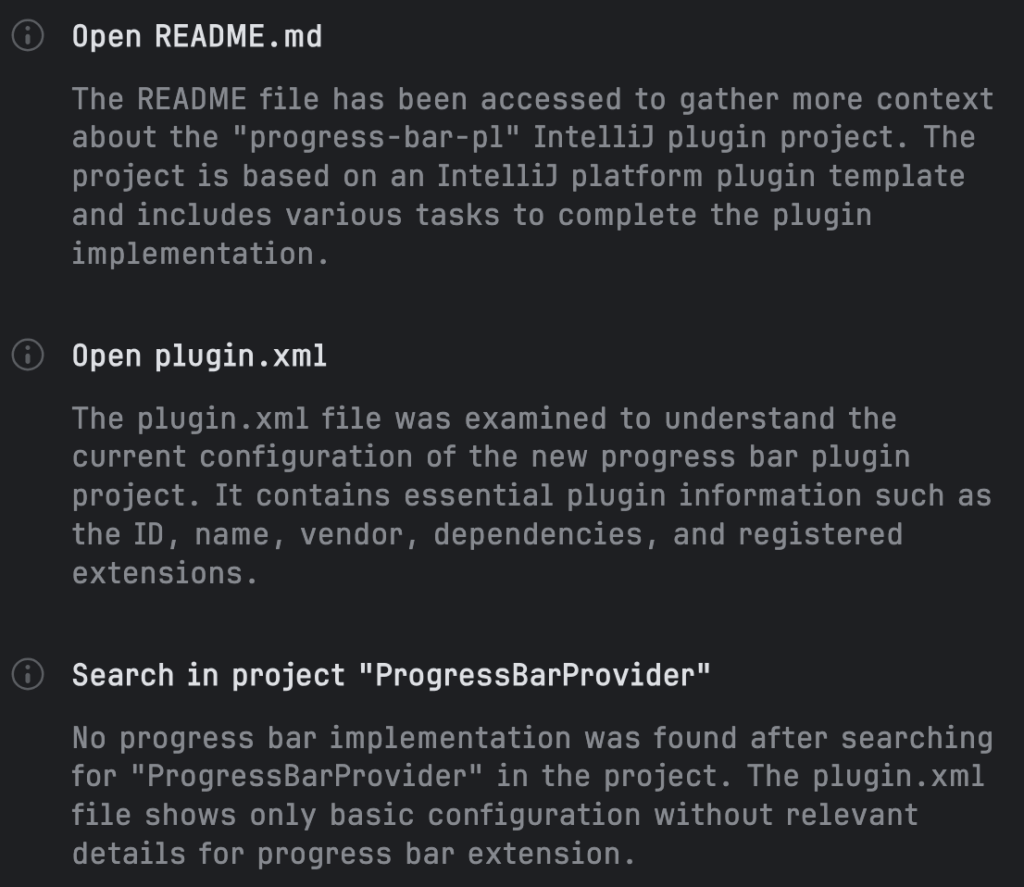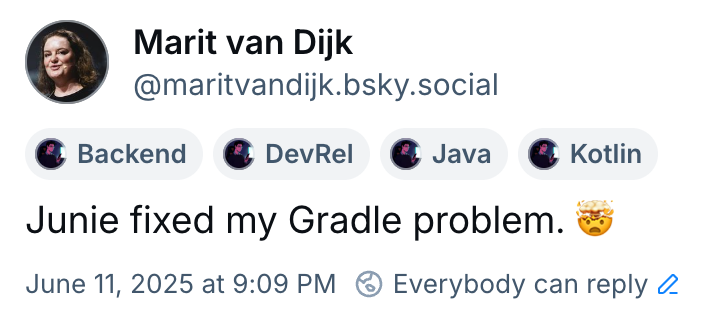In June, I presented the talk Learning modern Java the playful way with Piotr Przybył at Devoxx Poland 2025. For this presentation, I thought it would be funny to have a custom progress bar running in IntelliJ IDEA during our demos. Since we adapted our presentation to the Polish audience a little, I figured a Polish flag and #PolishSmile would be appropriate.

Creating an IntelliJ IDEA plugin
As I had never implemented an IntelliJ IDEA plugin before, I had no idea how hard it would be. When I asked my colleague, Anton Arhipov, he suggested using Junie to vibe code it. And given that this was just a fun idea for a plugin intended to be used only once, it was the perfect candidate for vibe coding: We don’t care that much about the code quality, since we won’t be maintaining it. All we need is for the plugin to work.
We started a new project using the Plugin template on GitHub. While Junie may or may not be able to do the configuration for such a project, there is a deterministic template available; why not use that?
When you open the project, IntelliJ IDEA will show a popup Suggested plugin Plugin DevKit available. Clicking the button Configure plugins will open Settings | Plugins with this plugin selected and the option to Install it.


Using Junie for vibe coding
Then we started with a prompt asking Junie to implement the plugin similar to the Nyan Progress Bar plugin. The prompt we used was as follows:
“Please implement a progress bar plugin similar to the nyancat progress bar. Instead of Nyancat I want it to display a Polish flag on the progress bar instead of the rainbow and a neutral smile emoji instead of the nyan cat. PLease suggest a detailed implementation plan and implement the plugin.”

Junie correctly identified that no implementation was available and set about creating one. Before doing so, it first scanned the project and looked at the README and plugin.xml, correctly identifying that “the project is based on an IntelliJ platform plugin template”.

The plugin template project includes multiple Gradle goals, including runIDE; which allows you to run your plugin on an instance of the IDE so that you can try it out. This is perfect for our vibecoded project, since all we care about is whether the plugin does what we want.

When Junie is done, it will say so in the Junie tool window and give an overview of files that were changed. The links to the files are clickable, if you want to look at the diff for these files.

First results
The first implementation of the progress was a step in the right direction but not quite what we wanted. Instead of a continuous Polish flag, it showed only small sections of white and red. Also, while the code referenced an icon, no icon was available, so we had to download a Polish smile emoji ourselves and add it to the project in the right location. We also had to manually resize this image to fit the progress bar, which unfortunately made it slightly pixelated…

One of the things I like about Junie is that it can to build your project, and will try to fix any issues if the project doesn’t build successfully. It might not try to do so every time (AI is non-deterministic after all), so if it doesn’t you might want to add something to your `.junie/guidelines.md` along the lines of “DO make sure the project builds successfully.
Also, Junie might stop if it cannot resolve issues in several tries. This is usually a hint to either break up the task into smaller pieces and/or provide more detailed information.
In our example, we tried prompting Junie to make the Polish flag on the progress bar continuous, but with no luck. We used the following follow up prompt:
“i want the brogress bar to be continuous and smooth and it should move 5 times slower”.
(Note that even though the prompt has typos, Junie doesn’t seem to mind.)
Providing a code example for better results
Unfortunately, this prompt did not have the desired outcome. Instead, Anton had the idea to take part of the Nyan Progress Bar plugin implementation and provide that code to Junie as an example to work with. We did so and used the following prompt:
“analyze the code in NyanCatProgressBar.txt (it is in Java) and create PolishFlagBProgressBar in Kotlin by following the same logic but with the polish flag colors”
This turned out to be a great idea; the plugin showed a continuous Polish flag now. This goes to show that providing Junie with examples of what you want will lead to better results.
Unfortunately, the smiley still jumped up and down on the progress bar, which is not what I wanted. But I figured it was good enough for a plugin I would only use for fun anyway. It wasn’t until after the conference that I realised that the smiley jumped up and down because that is what the Nyan Cat does in the Nyan Progress Bar. It took me five minutes to prompt Junie to fix this.
The next challenge was to build the plugin in a way that I could install it in IntelliJ IDEA from disk (as I had no plans to publish the plugin). A plugin project can be built using the task buildPlugin. Unfortunately this didn’t work for our project. It took several tries to get Junie to fix it, but I have to say that I was impressed that Junie fixed my Gradle problem.

Installing the plugin
Once the project was built successfully, I could install it. To install a plugin from disk, open Settings (⌘, on macOS) / Ctrl+Alt+S on Windows/Linux) and go to Plugins. On the Plugins page, next to Marketplace and Installed, click the icon to Manage Repositories, Configure Proxy or Install Plugin from Disk. From the menu, select Install Plugin from Disk, and select the .jar file for the built plugin from your file system.

Uninstalling the plugin
When it came time to uninstall the plugin, I found that I had trouble doing so. Fortunately my colleagues were able to provide a workaround. To manually uninstall the plugin, delete the plugin from the plugins main directory, which you can find in Help | Diagnostic Tools | Special Files And Folders.
Results
Remember, this plugin is not meant to be published to the marketplace. However, if you’re interested in the code, you can find it here.
Overall, it was fun vibe code something silly with Junie and I am happy with the result. Also, it turns out, I could actually reuse the plugin when speaking in Poland again.
